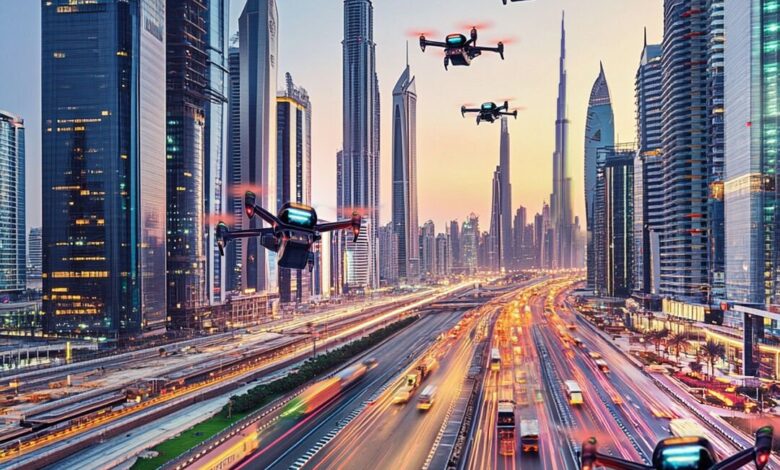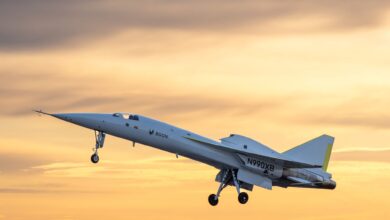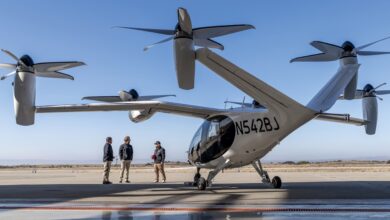
- Knowledge is power
- The Future Of Possible
- Hibs and Ross County fans on final
- Tip of the day: That man again
- Hibs and Ross County fans on final
- Spieth in danger of missing cut
Introduction
The United Arab Emirates (UAE) has embarked on a groundbreaking initiative to map air corridors for air taxis and cargo drones, marking a significant milestone in the development of Advanced Air Mobility (AAM). This initiative is part of the country’s broader strategy to revolutionize urban transportation and logistics by integrating autonomous aerial vehicles into its airspace.
With Dubai aiming to be among the first cities globally to launch air taxi operations, the UAE’s efforts to designate specific air corridors will ensure safe, regulated, and efficient operations for these emerging aviation technologies.
Why Is the UAE Leading the Way in Aerial Mobility?
The UAE has consistently positioned itself at the forefront of aviation innovation, thanks to its:
- Strong regulatory framework and forward-thinking aviation policies.
- Investment in smart city infrastructure to integrate air taxis into urban transport.
- Global partnerships with eVTOL and drone manufacturers, including Joby Aviation, Archer Aviation, and EHang.
- Proactive collaboration with aviation authorities such as the General Civil Aviation Authority (GCAA) and Dubai Civil Aviation Authority (DCAA) to develop a structured airspace for aerial mobility.
This new initiative to map air corridors for air taxis and cargo drones aligns with the UAE’s Vision 2031, which focuses on smart mobility, sustainable aviation, and cutting-edge transportation solutions.
What Are Air Corridors for Air Taxis and Cargo Drones?
Air corridors are predefined aerial routes specifically allocated for air taxis and cargo drones to fly safely and efficiently, minimizing risks related to:
- Collision avoidance with commercial air traffic.
- Restricted airspace near airports, military zones, and populated areas.
- Integration with existing air traffic control (ATC) systems.
- Ensuring privacy and security in urban environments.
These corridors will function similarly to road lanes in the sky, with designated routes for different types of aerial vehicles, ensuring a smooth and regulated flow of autonomous air traffic.
How Will the UAE Implement This Initiative?
The UAE’s General Civil Aviation Authority (GCAA) is leading this initiative in collaboration with:
- Dubai’s Roads and Transport Authority (RTA)
- Dubai Civil Aviation Authority (DCAA)
- Air taxi manufacturers and operators
- Local and international aerospace firms
- Smart city planners and AI-driven air traffic management providers
The implementation plan consists of several key phases:
-
Data Collection & Mapping
- Identifying optimal flight routes above key urban areas and logistics hubs.
- Assessing high-traffic zones, no-fly areas, and emergency landing spots.
- Integrating AI and machine learning for real-time airspace monitoring.
-
Regulatory & Safety Approvals
- Developing strict air traffic management protocols for autonomous aerial vehicles.
- Setting up emergency response procedures for unmanned aircraft failures.
- Enforcing cybersecurity measures to protect against hacking or unauthorized access.
-
Infrastructure Development
- Establishing vertiports (takeoff and landing zones) in urban and suburban areas.
- Deploying AI-driven air traffic control (ATC) systems.
- Integrating aerial mobility solutions into Dubai’s existing smart transport ecosystem.
-
Test Flights & Pilot Programs
- Conducting controlled flight tests with air taxis and cargo drones.
- Assessing safety measures, reliability, and public acceptance.
- Launching commercial services in limited regions before full-scale implementation.
Which Companies Are Involved?
Several global aviation and drone technology companies are working closely with the UAE on this initiative, including:
- Joby Aviation (USA) – Developing eVTOL air taxis with the capability for commercial service in Dubai by 2025.
- EHang (China) – Partnering with UAE authorities for trials of autonomous air taxis.
- Airbus Urban Mobility – Working on urban airspace integration strategies.
- Archer Aviation (USA) – Planning test flights and certification for its Midnight eVTOL aircraft in the UAE.
- Volocopter (Germany) – Collaborating with Dubai RTA to establish vertiports and aerial routes.
With multiple stakeholders involved, Dubai could be one of the first cities to offer fully operational air taxi services, reshaping the future of transportation.
Potential Benefits of Air Corridors for Air Taxis and Cargo Drones
-
Reduced Traffic Congestion
- Aerial mobility can significantly cut travel times within busy metropolitan areas.
- Air taxis can replace short-haul car trips, reducing road traffic pressure.
-
Enhanced Cargo & Logistics Operations
- Drones can transport medical supplies, urgent deliveries, and e-commerce packages faster than traditional road transport.
- Reducing dependency on road transport for last-mile delivery.
-
Eco-Friendly Transportation
- Air taxis and cargo drones use electric power, reducing CO₂ emissions.
- The UAE aims to achieve net-zero emissions in aviation by 2050, and integrating aerial mobility is part of that vision.
-
Job Creation & Economic Growth
- The urban air mobility (UAM) sector is expected to create thousands of high-tech jobs.
- Investment in air infrastructure, vertiports, and drone logistics hubs will drive economic diversification.
-
Faster Emergency Response
- Emergency drones can deliver life-saving equipment (AEDs, blood supply, medicine) in minutes.
- Air taxis can serve as fast-response ambulances, significantly reducing medical evacuation times.
Challenges & Considerations
Despite the promise of urban air mobility, several challenges need to be addressed:
- Regulatory Approvals – Ensuring global aviation safety standards are met.
- Public Perception – Overcoming skepticism about air taxis and drone safety.
- Noise & Environmental Impact – Managing public concerns about noise pollution.
- Cybersecurity – Implementing strong digital security measures to prevent hacking.
Dubai’s proactive approach to testing, regulation, and infrastructure development positions it as a leader in overcoming these challenges.
Future Outlook: What’s Next?
By 2025, Dubai aims to have its first commercial air taxi services operational, with key routes mapped out for urban transportation and logistics.
By 2030, the UAE’s advanced air mobility ecosystem will be fully integrated, with:
- Dozens of air corridors for air taxis and cargo drones.
- Fully operational vertiports across Dubai and Abu Dhabi.
- Autonomous drone delivery services running across logistics hubs.
- International collaborations ensuring global standards.
The UAE’s leadership in air mobility development serves as a model for other smart cities, paving the way for a future where urban air transport becomes as common as ride-sharing today.
Conclusion
The UAE’s initiative to map air corridors for air taxis and cargo drones is a bold step toward transforming urban transportation. By leveraging advanced air mobility solutions, the UAE is set to lead the world in integrating aerial transport into everyday life.
As Dubai gears up to launch its first air taxi services, the future of urban aviation looks promising, with faster commutes, sustainable travel, and efficient cargo deliveries becoming a reality.


